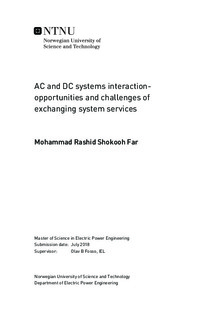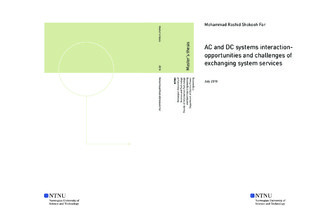| dc.description.abstract | Today, the world is facing a situation where only having an energy source is not the final priority, but, also having a clean energy source is the final concern. Where clean energy generation is concerned, only renewable energy resources come into the picture rather than conventional power generation sources. The tendency towards renewable energy sources has grown incredibly in recent years. It can be stated that wind and solar energy sources have the highest share of renewable energy sources. Nowadays, wind farms are usually located far away from load centers. Therefore, strong power transmission systems are required to transmit bulk power over long distances based on AC or DC solutions. Several detailed comparisons have been performed on High Voltage Alternating Current (HVAC) vs High Voltage Direct Current (HVDC) systems. It can be noted that the HVDC transmission system is the more feasible solution to transmit power in renewable energy power systems, especially collecting power from offshore power plants and distributing it among onshore consumers.\\
Line Commutated Converter (LCC) and Voltage Source Converter (VSC) are two available technologies in HVDC transmission systems. VSC (modern HVDC) technology with Pulse Width Modulation (PWM) has a number of advantages compared to the classical thyristor-based converters, such as the separate and fast-acting controls of active and reactive powers. Hence, VSC is the most suitable converter technology to make a multi-terminal DC (MTDC) power transmission system. It is desired that MTDC systems be capable of interfacing with all types of AC systems since the dynamic of MTDC systems is very fast. The main objectives to construct and use MTDC systems are the large-scale integration of renewable energy sources into the existing AC grids and the expansion of international energy markets through super grids.\\
This thesis presents ancillary services from HVDC systems and analysis power transmission systems based on VSC technology. The main focus of this thesis is to investigate the interactions of AC and DC grids and sharing power between them. A network based on MTDC power transmission system is designed in MATLAB/Simulink by developing a Matlab example to demonstrate interactions between the four AC grids and the MTDC system. In the test model, two AC systems, which are located at two different areas, are transmitting power via two VSCs (rectifiers) to two VSCs (inverters), and the inverters are finally connected to two other AC systems. Dynamic performance of the VSC MTDC system is examined by simulating different conditions to illustrate the energy balance in multi-area grids. Detailed simulations results are presented for normal operation and two case studies with different control strategies, such as active power control and DC voltage droop control to illustrate the behavior of the entire system under different conditions. | |

